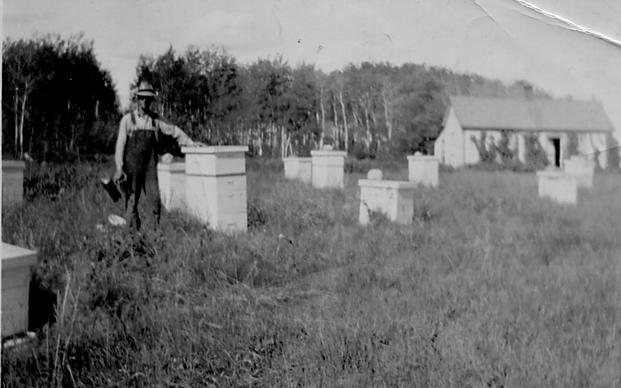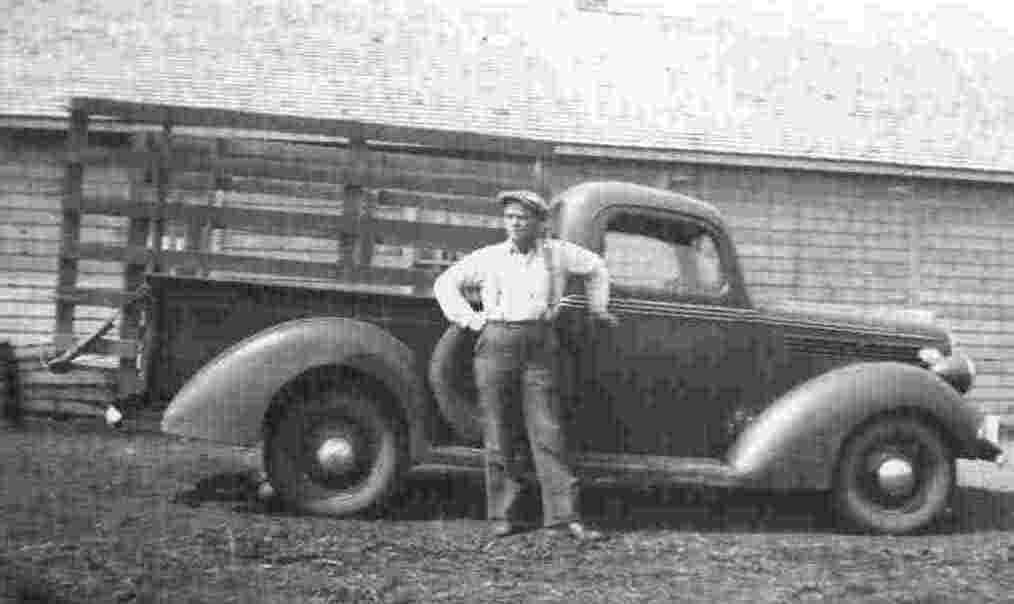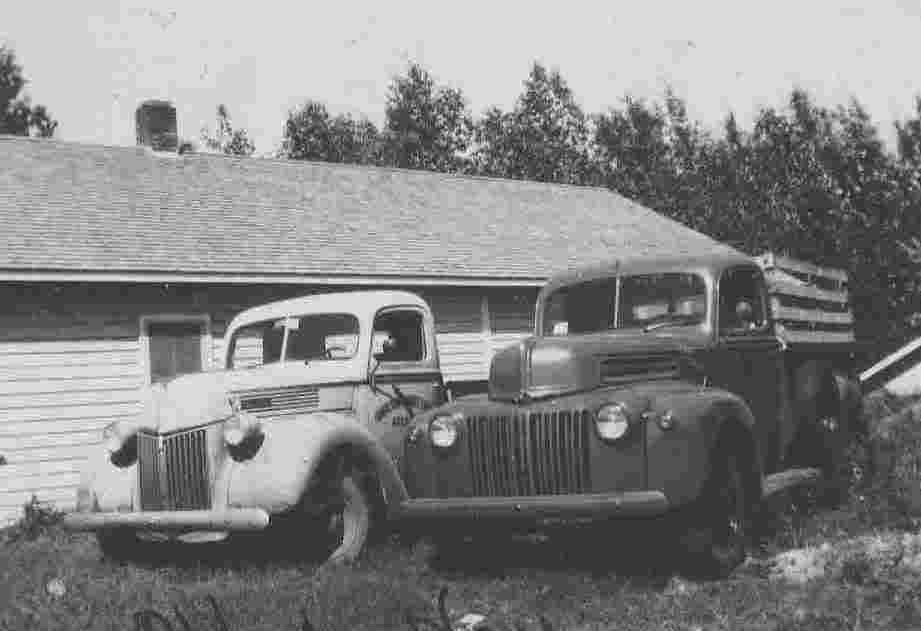Bob Hamilton - in the beginning
Garelochead, Scotland
In 1924 at Neudorf

In Aylsham 1945


Hauling Bees from California in 1960

Family Herald Jan.12, 1960 p.7 article with Bob's history
the right amounts and time. Naturally in those days of male superiority they called her a king. "Later," explains Mr. Hamilton, "it was found that the queen wasn’t boss of the hive and that apparently there was no individual boss. Then men couldn’t figure out how orders were given, especially after some early researchers decided that bees can’t hear." Other research workers began to wonder if bees might get their messages by smell. Then a few years ago, a German scientist, Von Frisch publicized the theory that bees perform dances which spell out certain information, to their watching sisters. Mr. Hamilton doesn’t agree. "When a bee comes in with a load of honey from a new clover patch," he says, "he certainly does a lot. of wig-wagging but that could just be joy. It makes a lot more sense to say he unloads his honey and makes a special sound that leads the other bees to the honey patch. If he did a dance how would all the bees in the other hives out of sight get his message? The whole yard learns, not just one hive. "I don’t think bees have human intelligence but they can express themselves in a language they can put to immediate use. If you believed they got their information through watching a pattern they’d have to be able to store up information and follow it like a man whose wife tells hint to go downtown for a certain brand of tea. "Bees can use their language in many ways to order the work of the hives Let’s suppose that the nurse bees need water to mix with the pollen they’re feeding the larvae. They could make a special noise and the bees nearby would fetch water until the noise changed." On the other hand, a hive that is about to swarm has a different sound, from one that has nothing on its mind but honey production, Mr. Hamilton points out. And a hive that is robbing honey from another has still a different sound from one that is being robbed. If one hive is robbing it isn’t long until all the hives in the area catch on that there is easy honey to be got and will join in. The bees in the other hives get the news by sound, Mr. Hamilton believes. A hive that is being robbed is probably one without a queen. Here, says Mr. Hamilton, the bees make a sad sound reflecting their dispirited status. Even in a hive equipped with a queen, there may be signs of strife. The queen is jealous of her role as the sole propagator of the race and will kill all rivals. However, the workers boss her around, and realizing that old queens die, they go ahead feeding a special royal jelly to certain grubs, turning them into new queens. Normally, the old queen leaves home or is pushed out by a swarm of workers seven days before the new queen’s hatch. If she is still there, however, she soon begins to hear the young queens imprisoned in their cells.
Note of Anger
"Then the workers have to force the queen to stay away from the cells or she’ll kill the young queens," Bob Hamilton explains. "if you listen you’ll hear the queen making an angry piping noise. I think she’s challenging them to fight. Before they come out of the cells you can hear the little queens piping back in a muffled way. They pipe only after the queen does. That means they’re ready to fight too." Bob Hamilton doesn’t know how bees make the sounds which he believes governs their lives. He knows that entomologists say bees have no vocal cords and therefore cannot speak the way humans do, but he points out that the cricket makes his song by rubbing his legs together. He thinks there are many ways a bee can make a noise, which means something to its hive-mates. Again, while the bee has no ears like humans she has nerves on various parts of her body, which might be sensitive to sound. Bob Hamilton has been within the sound of bees ever since he was a baby. There were bees humming on the farm where he was baby at Garelochhead in Scotland’s Highlands. When, as a lad of 16 he came to Canada in 1910, he wasted little time starting a hive on the farm where he worked near Neudorf, Sask. After four years with the Canadian army in the first World War Bob Hamilton came back to Neudorf, bought a farm under the Soldier’s Settlement Act and settled down to raising grain and honey. "I kept increasing my bees and during the thirties when we were dried out I was a part-time bee inspector," Bob says. It was while he was an inspector that he visited the Aylsham district in northeast Saskatchewan where the rain and trees made the country seem like paradise. Bob bought four and a half acres at the edge of Aylsham, moved his bees in during the spring of 1939 and has been there ever since. He went out of grain farming completely and at one time had 1,200 hives scattered about on farms. Bob, now 66, has dropped down to 800 hives the last three years. But it’s only since a heart attack that he has been forced to turn over most of the work to hired staff and has time to work on his theory about the language of bees. That, of course, is years away, but if serious research could carry Bob’s work further, it is possible that future scientists will be able to reproduce the sounds which attract grasshoppers, codling moths and potato bugs. Then, just like the Pied Piper of old who led the rats from Hamelin, the farmer may be able to charm the bugs right out of his fields.
page 7 FAMILY HERALD. Jan. 12, 1961
HISTORY OF EARLY
BEEKEEPING IN SASKATCEWAN
by
Robert Hamilton
Hamilton Honey Farms
Aylsham, Sask.
I have been asked
many times to write of my early beekeeping experiences in Saskatchewan, with a
view to recording some of the historical facts for the benefit of those who may
be interested. So I take up the pen, not because I like to write, but because
there have been many inaccuracies written on the subject by people who either
did not know or else were going by hearsay.
Just who brought
in the first bees to this province may never be known. We do not know how successful the provinces
first beekeepers were. It seems likely that they kept bees one or at the most
two seasons before their colonies died out and were never replaced. Probably
the most notable of the early beekeepers were the Couper
Brothers who started the Moose Mountain Apiaries. This venture only lasted
about two years. They had about thirty colonies and in writing to the British
Bee Journal stated that Saskatchewan was unsuited to beekeeping and that they
were moving to British Columbia. This was in 1908.
Coming to Canada
in 1910 from Scotland and being raised in a beekeeping family, it was only
natural I would be interested in the beekeeping practices of Saskatchewan. What
I saw looked good, so in the spring of 1911 I purchased two colonies from Mr.
R.J .T • Muckle of Clandeboye,
Manitoba, who had pioneered beekeeping in that province. Those bees produced a
nice crop of honey entirely from wild flowers. From then on we never failed to
produce a good crop of honey, which usually averaged about 120 to 150 pounds
per colony and in the good Wolf Willow years nearer the 180 pound mark.
In those early
days we bad no cultivated plants useful to bees and therefore had to depend entirely
on wild flowers which, of course, were in great profusion in the park belt.
There was a large acreage of un-cultivated land and it all grew something
useful to the bees Where I
was located, in the Qu’Appelle Valley, the side hills were
covered with hundreds of acres of Wolf Willow and Crocus (or Anemone). In
recent years much of this bee pasture has disappeared through heavy grazing and
breaking up of the prairie. Our chief honey plants at that time were common
Willow, wild fruit bloom, Wolf Willow, wild Raspberry, Fireweed, Badger Brush,
Asters and Goldenrod. It made a fairly continuous honey flow, the heaviest
yielder being Wolf Willow. However, Wolf Willow only produced heavy bloom every
second year, but because it bloomed in June it was a wonderful boon for
wintered over colonies. The honey was white and had the delicate aroma of the
Wolf Willow flower.
Wintering was the
main stumbling block for the early beekeepers.
After thoroughly reading the Journals and, textbooks, we
experienced no trouble with wintering our bees which we did successfully in
root cellars under the house. It proved, at last, to the skeptics that
beekeeping was both practical and profitable in this province.
This account of
early beekeeping would not be complete without a word on the means of
transportation of bees to outyards
prior to 1920. At this time trucks
were practically unknown and so the only means of transportation was the
horse—drawn vehicle and this for the bees was the hayrack, On
this we placed about two feet of hay, to cushion. the
rough road as there were no springs or rubber tires. The hives were loaded then
tied down to prevent them from rocking and bumping each other. The hives, of
course, had to be securely lathed to prevent leakage of bees and as a safeguard
a rope was fastened from the draw pin to the top of the rack so that in case of
an emergency the. Draw pin could be pulled and the
horses got out of the way quickly. It was at that time quite common to read in
the Bee Journals of horses being killed when a hive being transported cane
apart. Today I don’t think we fully realize how important the truck has been to
us and that commercial beekeeping as we know it today would be out of the
question without it.
The year 1913 saw
two others start beekeeping successfully in the persons of John Street of Grand
Coulee and John Watson of Ituna. John Street became
blind but continued to keep bees later moving to B.C. where he was known as the
Blind Beekeeper of Haney”.
The eight-frame
hive was standard equipment up to this time, however, the next ten years saw
the ten—frame hive take its place, The
next ten years also saw a considerable expansion in beekeeping,
mainly on account of the introduction of Sweet Clover as a farm crop.
Bees could only be
purchased as colonies on combs and the short supply controlled the number able
to start beekeeping. One of those
who became interested in bees at this time was John Hubbard of
Grenfell, a neighbour of mine. He purchased two hives from Manitoba in 1918 and
his boundless enthusiasm did much to interest others in beekeeping.
1923 was an
historic year for Saskatchewan beekeeping. It saw the first importation of
packaged bees which were to play a most important part in the expansion and
success of beekeeping in this province. It also saw the birth of our Beekeepers
Association.
Tom Mack of Lumsden, another enthusiast, together with John Hubbard and
myself took the matter of organizing the Association
assisted by Hedley Auld who was then Deputy Minister of Agriculture. Mr. Auld
gave us his whole hearted support and drew up a draft cOnstitution.
He also arranged for the first meeting in a tent at the Regina Fair in August
1923. About twenty people attended. Officers elected were John Hubbard,
Grenfell as President; Tom Mack, Lumaden as
Vice—President; Dr. Nerkley, Moose Jaw as Secretary.
Directors were: Dr. C.F. Patterson, Saskatoon; Conrad Steuk,
Abernethy; Robert Hamilton, Neudorf; and another
whose name I cannot remember.
The association
did yeoman service in starting the industry off on the right foot. We ran an
exhibit at the Regina Fair in a booth provided by the Department of
Agriculture. Tom Mack and I ran this booth for several years and the amount of
information given to those interested helped many to make a proper start. I
also had a wire screen cage in which I gave live bee demonstrations three times
daily, making a beard of bees by pouring them over my head. It was agreed I had
the best show on the grounds and I believe it was responsible for many taking
up beekeeping.
In the years
between 1923 and i926, I did some inspection work for the Department of
Agriculture. It was the first disease inspection work in Saskatchewan and I
carried it out in the Abernethy and Balcarres
districts in 1921. But as time went on it was felt that someone should be
permanently employed to supervise the inspection and educational work connected
with the industry so we approached the Government with our re-quest. Late in
the fall of 1926, the Minister of Agriculture, the Hon. C.N. Hamilton, asked me
to take on this work, but I had to decline as I had made prior arrangements to
go into commercial beekeeping, The following spring R.M. Pugh was appointed and
this took a great deal of work off the Association,
The first short
course in beekeeping was held in February, 1926, and was conducted by R.M.
(Bob) Muckle who had just retired as Provincial
Apiarist for Manitoba, I represented the Association
at this course and got most of those taking the course to join the Association,
which boosted our membership.
One also remembers
the beekeeping picnics which were usually held at the Hubbard farm at Grenfell,
as it was considered more accessible and central for those wanting to attend, However, we held them at other points as well - one
year at the George Murray farm at Saltcoats.
In looking back to
those days the thing that strikes one most I think, was the rapid turnover of
beekeepers. Most of those starting
stayed with it only a year or two. This was probably caused from being
unable to get sufficient information. In other cases the person was too old to
acquire sufficient confidence to handle bees.
The centre of
beekeeping in the early years was mainly in the south eastern part of the
province from Regina east to Moosomin and north to
Yorkton and Canora. Today, it was moved north to the
Carrot River Valley where the commercial beekeeper produces large crops of
choice white honey.
EDITORIAL
Mr. Robert
Hamilton kept bees in Scotland before coming to Saskatchewan in 1910 where he
was soon operating one of the provinces first commercial apiaries at Neudorf. During the dry 30's he moved to greener pastures
in northern Saskatchewan, Operating 800 colonies out of Aylsham
and ably assisted by his wife Cora and family in the packing operations.
He has packed the popular Northern Blossom honey. His son,
Bill, now operates his own outfit - the Hamilton Bee Ranch at Nipawin. We are
pleased to offer our readers Bob Hamilton's account of early
beekeeping in Saskatchewan.
S.E. Bland
Editor